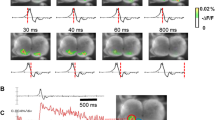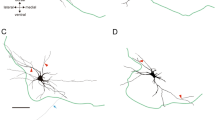Summary
Intracellular recording and staining techniques were applied to the study of cat phrenic motoneurons. Spontaneously driven phrenic cells possessed individualistic depolarization and spiking patterns that were a function of the conduction velocity in the different motor axons. Staining of phrenic motoncurons with Procion yellow indicated that fast conducting cells with small slow-wave depolarizations were large in size while slow conducting cells with large depolarizations were small in size. This implicated differences in membrane input resistance between large and small cells, although an unequal distribution of inputs to the individual components could not be discounted.
On the average, phrenic motoneurons had a smaller dendritic surface area and smaller dendritic dominance than lumbosacral motoneurons. These factors help to explain the higher membrane resistances and longer time constants of phrenic cells.
Phrenic dendrites were found to project in all directions away from the cell body and form ellipsoidal receptive fields that overlapped with other phrenic fields. It is speculated that the close approximation of phrenic dendrites with one another could, in part, be responsible for the high degree of synchronization among the different phrenic units.
Similar content being viewed by others
References
Aitken, J. T., Bridger, J. E.: Neuron size and neuron population density in the lumbosacral region of the cat's spinal cord. J. Anat. (Lond.)95, 38–53 (1961)
Barrett, J. N., Crill, W. E.: Specific membrane resistivity of dye-injected cat motoneurons. Brain Res.28, 556–561 (1971)
Barrett, J. N., Crill, W. E.: Specific membrane properties of cat motoneurons. J. Physiol. (Lond.)239, 301–324 (1974a)
Barrett, J. N., Crill, W. E.: Influence of dendritic location and membrane properties on the effectiveness of synapses on cat motoneurons. J. Physiol. (Lond.)239, 325–345 (1974b)
Barrett, J. N., Graubard, K.: Fluorescent staining of cat motoneurons in vovo with beveled micropipettes. Brain Res.18, 565–568 (1970)
Baumgarten, R. von, Schmiedt, H., Dodich, N.: Microelectrode studies of phrenic motoneurons. Ann. N. Y. Acad. Sci.109, 536–544 (1963)
Conradi, S.: On motoneuron synaptology in adult cats. Acta physiol. scand., Suppl.332, 5–115 (1969)
Eccles, J. C.: The physiology of nerve cells. Baltimore, Md.: Johns Hopkins Univ. Press, 1957
Gill, P. K., Kuno, M.: Properties of phrenic motoneurons. J. Physiol. (Lond.)168, 258–273 (1963a)
Gill, P. K., Kuno, M.: Excitatory and inhibitory actions on phrenic motoneurons. J. Physiol. (Lond.)168, 274–289 (1963b)
Henneman, E., Somjen, G., Carpenter, D. O.: Functional significance of cell size in spinal motoneurons. J. Neurophysiol.28, 560–580 (1965a)
Henneman, E., Somjen, G., Carpenter, D. O.: Excitability and inhibitibility of motoneurons of different sizes. J. Neurophysiol.28, 599–620 (1965b)
Hodes, R.: Selective destruction of large motoneurons by poliomyelitis virus. I. Conduction velocity of motor nerve fibers of chronic poliomyelitis patients. J. Neurophysiol12, 257–266 (1949)
Hursh, J. B.: Conduction velocity and diameter of nerve fibers. Amer. J. Physiol.127, 131–139 (1939)
Kernell, D.: Input resistance, electrical excitability, and size of ventral horn cells in cat spinal cord. Science152, 1637–1640 (1966)
Keswani, N. H., Hollinshead, W. H.: The phrenic nucleus. III. Organization of the phrenic nucleus in the spinal cord of the cat and man. Proc. Mayo Clin.30, 566–577 (1955)
Matthews, M. A., Willis, W. D., Williams, V.: Dendrite bundles in lamina IX of cat spinal cord: a possible source for electrical interaction between motoneurons?. Anat. Rec.171, 313–328 (1971)
Rall, W.: Branching dendritic trees and motoneuron membrane resistivity. Exp. Neurol.1, 491–527 (1959)
Schadé, J. P.: On the volume and surface area of spinal neurons. Progr. Brain Res.11, 261–277 (1964)
Scheibel, M. E., Davies, T. L., Scheibel, A. B.: Maturation of reticular dendrites: Loss of spines and development of bundles. Exp. Neurol.38, 301–310 (1973)
Scheibel, M. E., Scheibel, A. B.: Organization of spinal motoneuron dendrites in bundles. Exp. Neurol.28, 106–112 (1970)
Sterling, P., Kuypers, H. G. J. M.: Anatomical organization of the brachial spinal cord of the cat. II. The motoneuron plexus. Brain Res.4, 16–32 (1967)
Wyman, R. J., Waldron, I., Wachtel, G. M.: Lack of fixed order of recruitment in cat motoneuron pools. Exp. Brain Res.20, 101–114 (1974)
Author information
Authors and Affiliations
Rights and permissions
About this article
Cite this article
Webber, C.L., Pleschka, K. Structural and functional characteristics of individual phrenic motoneurons. Pflugers Arch. 364, 113–121 (1976). https://doi.org/10.1007/BF00585178
Received:
Issue Date:
DOI: https://doi.org/10.1007/BF00585178




